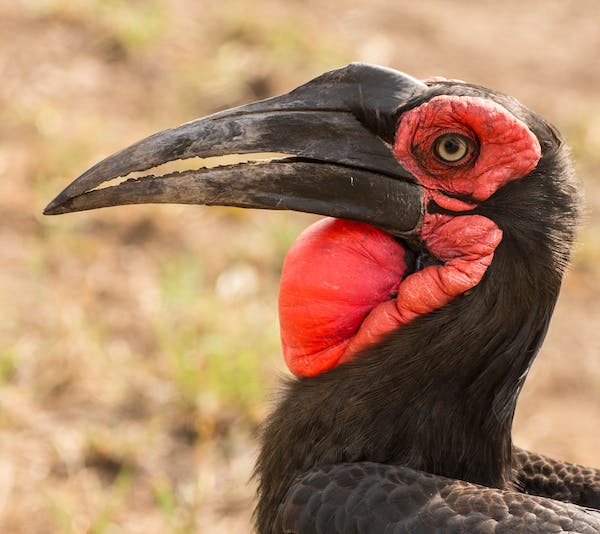The Southern Ground Hornbill, also known as Bucorvus leadbeateri, is one of the only two species under the Ground Hornbill, which are only found within the African continent. The other hornbill species is the Abyssinian Ground Hornbill, also known as the Northern Ground Hornbill, which is usually found in Africa’s northern parts.
The Southern Ground Hornbill was first described by Irish zoologist and politician Nicholas Aylward Vigors in 1825. This species is culturally pervasive and vital in southern Africa. The Kruger National Park in South Africa listed the Southern Ground Hornbill as one of their “Big Six” bird species. But sadly, their population has been declining due to persecution, habitat destruction, cultural principles, and other factors. Thus, the International Union for Conservation of Nature (IUCN) Red List categorized this species as Vulnerable in 2018 and Endangered in several countries such as Lesotho, South Africa, Swaziland, and Namibia.
Its seven levels of scientific classification are as follows:
Kingdom: Animalia
Phylum: Chordata
Class: Aves
Order: Bucerotiformes
Family: Bucorvidae
Genus: Bucorvus
Species: B. leadbeateri
The physical characteristics of a Southern Ground Hornbill
This hornbill species comes with dark, bold colors, and it shoots a rather menacing look, which makes it quite intimidating to others. It is recognized as the largest bird in the hornbill family, measuring up to 100 cm tall. It resembles its closest relative, the Northern Ground Hornbill, but they differ in markings. The plumage of the Southern Ground Hornbill is black with white primary feathers.
Sexual dimorphism is present in this species. A male Southern Ground Hornbill has a continuous red coloring from their face down to the neck, while a female has blue coloration on the throat. This characteristic also differs from the Southern Ground Hornbills from the northern ones, as the latter possesses a completely blue face and neck. An adult Southern Ground Hornbill has a large beak, head, body, stocky legs, long lashes, and an inflatable throat sac. Juvenile Southern Ground Hornbills share the same plumage and primaries as adults. The only distinct difference is the coloring on their throats—the colors are subtle.
The distribution and habitat of Southern Ground Hornbills
The Southern Ground Hornbills are restricted to sub-Saharan Africa, particularly in southern Kenya, Botswana, northern Namibia, northern South Africa, south Zimbabwe to Burundi. These ground-dwelling birds are rarely arboreal. They live in dry habitats such as savannas, grasslands, and forests. Southern Ground Hornbills are also being taken care of in local parks to preserve their declining population.
The behavior of a Southern Ground Hornbill
These ground-dwelling birds often live in small groups of 2 to 11 birds. Within each group, there is a present alpha pair of male and female birds. This pair is chosen depending on the size and age of the birds. There is also a single dominant breeding pair within each group, while other hornbills act like “workers” within the group. A small flock may also include juvenile hornbills that are yet to live independently from their parents.
Southern Ground Hornbills are considered non-migratory birds. They remain in their territory for a year. “Worker” birds in groups help defend a particular territory. They do not vocalize that much, although callings are apparent during the breeding season. During this period, they make “booming” sounds, emitting cries by enlarging their air sacs then releasing the air. They also make a soft, booming sound when communicating with a family member.
The breeding season occurs in the early summer, although not every year. These ground-dwelling birds are monogamous, and their attraction is based on the size of the bird. There is only one mating pair in the group. The alpha female Southern Ground Hornbill will produce offspring while “worker” birds help take care of them. These birds reach sexual maturity at three years of age. During this period, the males’ faces become redder and the females’ throats turn violet-blue.
The diet of a Southern Ground Hornbill
Southern Ground Hornbills are carnivorous birds that feed on terrestrial animals and reptiles. When there is a limited source of prey, it eats on carcasses. Their primary sources of food include insects. They hunt by walking around in groups and using their large beaks to attract prey. Sometimes, they will collect prey and store their food somewhere and then eat it one by one.
BOTSWANA BIRDS | SOUTH AFRICA BIRDS
NAMIBIA BIRDS | ZAMBIA BIRDS | ZIMBABWE BIRDS

